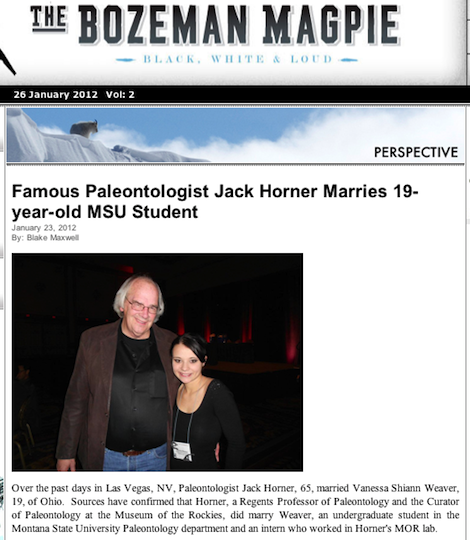Marc Abrahams's Blog, page 602
January 26, 2012
Nifty stereogram converter from NY public library
 The New York Public Library web site has a tool that lets you take stereo photos, and convert them into a single moving, apparently 3-D, image. An example is shown here. They invite you to:
The New York Public Library web site has a tool that lets you take stereo photos, and convert them into a single moving, apparently 3-D, image. An example is shown here. They invite you to:
Create and share animated GIFs and 3D anaglyphs using more than 40,000 stereographs from The New York Public Library.
Joshua Heineman is the key person who inspired this, says the Library. The web site gives lots of detail.
[via metafilter]

Dinosaur hunter Horner hoax? Huh?
Investigator Virginia Cox sent us this note:
If you, like me, like dinosaurs, you have been following the adventures of paleontologist Jack Horner. He is my hero. Can you or one of your readers tell me, though, if this is a hoax?
A newspaper called the Bozeman Magpie has this report: "Famous Paleontologist Jack Horner Marries 19-year-old MSU Student"
I looked on Jack Horner's page on Wikipedia. The very first thing it says is:
"John 'Jack' R. Horner (born June 15, 1946) is an American paleontologist who discovered and named Maiasaura, providing the first clear evidence that some dinosaurs cared for their young."
Those words feel a lot different in light of this new romantic news.
Then I looked up the name of the young lady, and found a facebook page. It says she is married to "John Horner", and shows a wedding photo of her and her husband. It lists the "people who inspire Vanessa". There are: "Dinosaurs, John Wayne, Barney, and John R. Horner". Then something really strange. Under the heading "Activities" it lists only one thing: "Don't dump a girl, and then get mad when she finds someone else".
Did the master get tired of looking for old things, and instead go hunting for young ones? Or is this a hoax? Or am I crazy? Now I'm wondering if his name really is "Horner" — it seems a little too descriptive.
If anyone can help answer Investigator Cox's letter, please do.

Swearing Can Repel Emotional Support
A new paper is the first (by other authors) to cite the 2010 Ig Nobel Peace Prize-winning paper by Richard Stephens, et al., about how swearing relieves physical pain. The new study is:
 "Naturalistically observed swearing, emotional support, and depressive symptoms in women coping with illness," Megan L Robbins, Elizabeth S Focella, Shelley Kasle, Ana María López, Karen L Weihs, Matthias R Mehl [pictured here], Health Psychology, Vol 30(6), Nov 2011, 789-792. The authors write:
"Naturalistically observed swearing, emotional support, and depressive symptoms in women coping with illness," Megan L Robbins, Elizabeth S Focella, Shelley Kasle, Ana María López, Karen L Weihs, Matthias R Mehl [pictured here], Health Psychology, Vol 30(6), Nov 2011, 789-792. The authors write:
Objective: The goal of this study was to explore the intra- and interpersonal consequences of swearing. Specifically, it investigated what implications swearing has for coping with and adjustment to illness.
Methods: …Participants wore the Electronically Activated Recorder, an unobtrusive observation sampling method that periodically records snippets of ambient sounds, on weekends to track spontaneous swearing in their daily interactions, and completed self-reported measures of depressive symptoms and emotional support.
Conclusion: [Our] exploratory results are consistent with the notion that swearing can sometimes repel emotional support at the expense of psychological adjustment.
BONUS: Richard Stephens, swearing, pain, Stephen Fry, and Brian Blessed, all together on the BBC discussing and demonstrating how swearing relieves pain.

January 25, 2012
Simple complex thought: Sex-attraction examples
Great thinkers think complex thoughts, according to one simple line of reasoning. Here's are two related studies. Alone and together, they demonstrate some surprising, and surprisingly complex, thinking. The first study [via NCBI ROFL] is:
"The best men are (not always) already taken: female preference for single versus attached males depends on conception risk," Paola Bressan [pictured here, thinking] and Debora Stranieri, Psychological Science, 2008 Feb;19(2):145-51.
The authors, at the University of Padua, Italy, explain:
"Because men of higher genetic quality tend to be poorer partners and parents than men of lower genetic quality, women may profit from securing a stable investment from the latter, while obtaining good genes via extrapair mating with the former. Only if conception occurs, however, do the evolutionary benefits of such a strategy overcome its costs. Accordingly, we predicted that (a) partnered women should prefer attached men, because such men are more likely than single men to have pair-bonding qualities, and hence to be good replacement partners, and (b) this inclination should reverse when fertility rises, because attached men are less available for impromptu sex than single men. In this study, 208 women rated the attractiveness of men described as single or attached. As predicted, partnered women favored attached men at the low-fertility phases of the menstrual cycle, but preferred single men (if masculine, i.e., advertising good genetic quality) when conception risk was high."
The study includes the following chart, the meaning of which is related to the central line of thinking in a complex way [not presented adequately here, due to space and other limitations]:
Bresson is also author of the seminally-related study that depends on complex thought:
"Why babies look like their daddies: paternity uncertainty and the evolution of self-deception in evaluating family resemblance," Paola Bressan, Acta Ethologica, 4, 113-118, 2002.
The reasoning involves a study done by an earlier scientist. Here is Bresson's simple description of that earlier complex reasoning. Here, too, is a simple list of the parameters used in that reasoning:

Delving into fecal transplants
Pagan Kennedy writes, in The Atlantic, the kinds of interest sparked by fecal transplants:
The Poop Outlaws: At-Home Fecal Transplants to Cure Disease…But such treatments still shimmer in the future. In the meantime, the best approximation we've got is, well, crap…. Lately, rumors about poop miracles have been proliferating on the Internet.
In patient support groups, people are buzzing about the possibilities of the procedure. Dr. Lawrence Brandt [pictured here], the chief of gastroenterology at Montefiore Medical Center in the Bronx, told me that he receives several emails a week from people begging for fecal transplants. It used to be just the c. difficile sufferers. But now he hears from people who are hoping to beat diabetes, autism, or obesity. It's not clear whether a gut bacteria can help with these complaints, but nonetheless many patients are hoping for a "poop miracle." They are at the forefront of a a fascinating revolution in medical science. Thanks to new genetic-sequencing tools, scientists are beginning to identify the bacteria that help us digest food, ward off disease, and stay thin. And though doctors still don't know how to use these bugs to cure us, many patients are ready to leap into the era of living medicine.
A few years ago, a team of Canadian doctors published a study of patients who tried the at-home transplants. The research paper is unusual in that it includes detailed instructions for performing the DIY medical procedure. It's as if — with a wink and a nod — the scientists are urging patients, especially those who have been turned away from hospitals, to operate on themselves.

Ig Nobel at GEL in NYC, for you to see
The GEL Conference, in New York City, has just posted video of the talk I did there. This was the conference's concluding talk:

Exciting Video: Opportunities in Marketing Research
It's time for still another visit with Nigel Bradley.
This is the most exciting video you will have seen during the minute and two seconds you were watching it. It's specially made for market researchers. It's called "Career Opportunities in Marketing Research". It's from Oxford University Press. It's right here:

BONUS: All about the star: Nigel Bradley

January 24, 2012
The medical effects of sword swallowing, perused
Jennifer Ouellette looks deep into the sword-swallowing and medical adventures of Ig Nobel Prize winner Dan Meyer, in her essay in Cocktail Party Physics. She begins:
By the Sword: The Science of Sword-SwallowingA couple of weeks ago, new media mogul Arianna Huffington had an unusual experience: assisting veteran sword swallower Dan Meyer, who was visiting the Huffington Post headquarters in New York City.Meyer heads the Sword Swallowers Association International, based in Antioch, Tennessee. He's a five-time Guiness Book of World Record Holder, and has appeared on America's Got Talent. He made it to the finals despite having a visibly squicked-out David Hasselhoff pull the plug halfway through Meyer's audition performance.
But we're sure he's most proud of his 2007 Ig Nobel Prize for Medicine, which he shared with Brian Witcombe, a consulting radiologist at Gloucestershire Royal NHS Foundation Trust in England. They were honored "for their penetrating medical report, 'Sword Swallowing and Its Side Effects,'" which was published to almost no fanfare in the British Medical Journal — maybe because it appeared right around Christmas and people were too busy swallowing Yorkshire pudding and opening prezzies to pay much attention to the findings….
BONUS: The photo below, taken at the 2007 ceremony, Dan Meyer punctuating his and Brian Witcombe's joint one-minute-long acceptance speech. Meyer and Dr. Witcombe (who is not visible in this photo, having stepped back to give his colleague breathing room) were honored for studying the medical side-effects of sword-swallowing. Nobel Laureates William Lipscomb, Robert Laughlin and Dudley Herschbach can be seen here analyzing Mr. Meyer's speech. Photo Credit: Alexey Eliseev.


Cat and Mouse – digitised
As anyone who has seen a stick thrown for a dog in the park will know, interspecies play is not that uncommon. But playing with another species via a computerised interface is considerably less prevalent. Strides, if not leaps and bounds towards such interaction have recently been made however . . .
Researchers Frank Noz (Carnegie Mellon University MHCII University of Madeira, Pittsburgh, Pennsylvania, USA) And Jinsoo An (Consultant, Pittsburgh, Pennsylvania, USA) have between them developed : Cat cat revolution: an interspecies gaming experience,(CHI '11 Proceedings of the 2011 annual conference on Human factors in computing systems.)
"The Cat Cat Revolution (CCR) is a digital game of cat and mouse that allows cats to participate in play through a species-appropriate interface. The game applies Human-Computer Interaction (HCI) principles to pets and casts pets as participants in the gaming experience."
"CCR explores how to successfully mediate the human pet play experience through a digital interaction"

Cotton bud quiz winner
 Many thanks to all those readers who sent in suggestions for the use of extra long cotton buds. (see: Cotton buds (Dangers of) 20th Jan.)
Many thanks to all those readers who sent in suggestions for the use of extra long cotton buds. (see: Cotton buds (Dangers of) 20th Jan.)
There were many amusing answers, some possibly less publishable, bearing in mind that some of our readers may be of a squeamish disposition (ouch).
But the winner of the quiz (IMHO) was Carlo Annaratone :
"Those cotton tips are clearly made to clean with microgrit abrasive powder the interior of British teapots, to bring them back to original shininess."
Another highly plausible, though perhaps less amusing (IMHO) use is suggested by the manufacturers, whose image of it is reproduced here.

Marc Abrahams's Blog
- Marc Abrahams's profile
- 14 followers





























